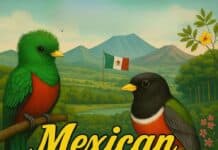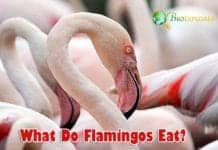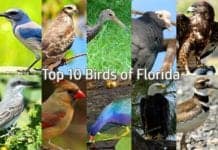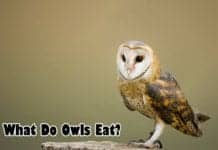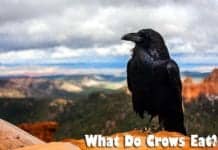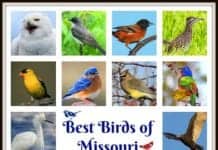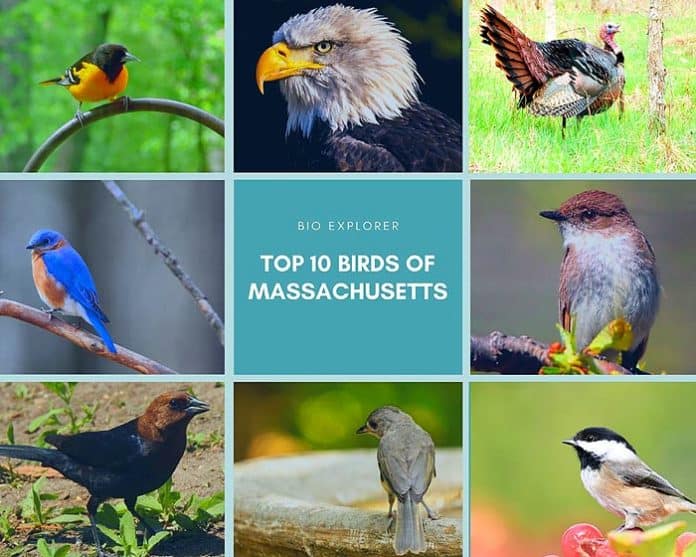
Birds of Massachusetts: Massachusetts is covered by 60.4% of the land (roughly 3 million acres) with five major forests, namely northern hardwoods, oak/hickory, white/red pine, mixed oak/white pine, and elm/ash/red maple.
According to 2017 Massachusetts forest survey publications, there are an estimated more than 1.6 billion live trees on the forest land in Massachusetts, which produce total above-ground biomass of 222.1 million tons. With its diverse habitats comprising of wetlands, forests, coastal habitats, salty marshes, highlands, and mountains, it is evident that the state is likely to host a wide variety of bird species.
Birds of Massachusetts
This article highlights some of the top 10 resident birds in the state of Massachusetts (MA) out of 300+ bird species, including where you can spot these beautiful birds within MA.
1. Name Black-capped Chickadee
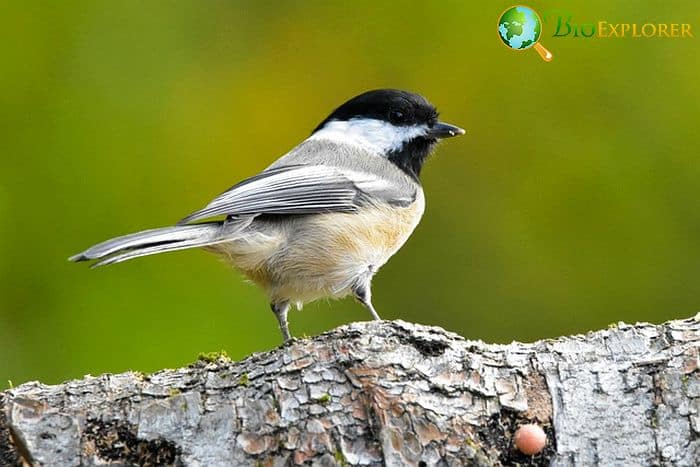
Black-capped chickadees obtain their name from the black feathers that cover their heads, creating the illusion that they are wearing a cap.
| Animalia | Passeriformes | Paridae | Poecile | Poecile atricapillus |
- The name “chickadee” is descended from the common calls of several species.
- The black cap extends to just below their eyes. The black-capped chickadee is a small bird whose adults grow to 5 inches tall.
- When feeding, these tiny birds are very active. Their small size and strong feet come in handy when looking for food.
- These frequent backyard birds can walk on twigs and edges or hang upside-down to pick prey. Chickadees are omnivorous and are known to store their food in penchants.
- These intelligent birds have a good memory, given their ability to recall the different locations they store their food.
- Black-capped Chickadees have the ability to lower their body temperature to survive the cold in the winter months. However, the similar-looking species Caroline Chickadees do not have this characteristic, causing them a high mortality rate during the winter months.
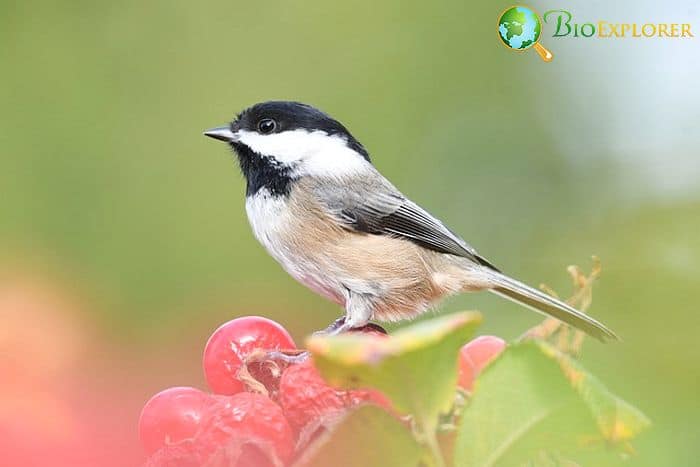
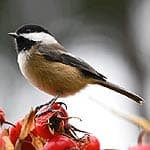
Black-capped chickadees can be found in virtually every corner of the Commonwealth of Massachusetts, as long as trees are present.
![]()
2. Wild Turkey
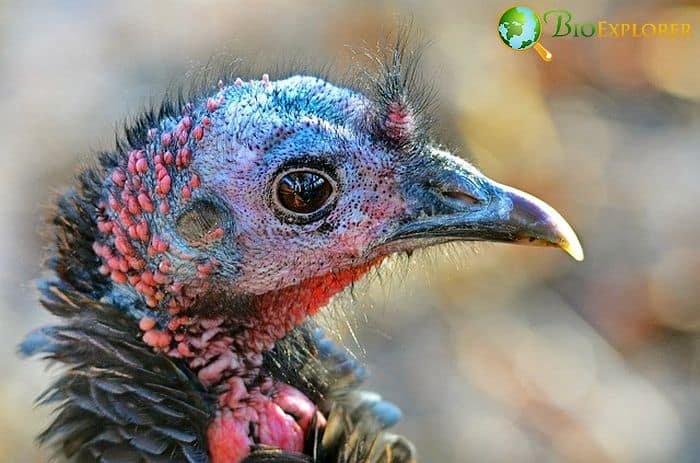
Wild turkeys are Massachusetts state’s official game birds. They are significantly large and heavy birds with long legs, slim necks, and wide rounded tails.
| Animalia | Galliformes | Phasianidae | Meleagris | Meleagris gallopavo |
- These largest galliform birds tend to have dark plumage with a bronze-green sheen notable on most of their feathers.
- Turkeys move in flocks, which is strategic because it helps them during their foraging quests. They mainly forage on forest floors.
- Their preferred foods include berries, acorns, nuts, insects, and snails. Only male members display their fan-like tails and bright beards.
- Wild turkeys are a common sight throughout New England states, where flocks are notable on the roadsides and the backyards.
- These Omnivorous birds were reintroduced to the region to revive their population, which had dwindled in New England because of habitat destruction and overhunting in the early 1900s.
- Wild turkeys are American history’s most successful reintroduced species. Once Benjamin Franklin proposed Wild Turkey as the national emblem of the United States.
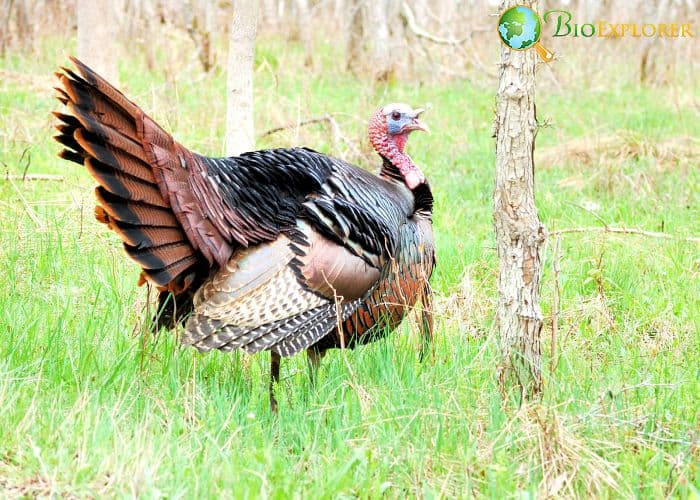
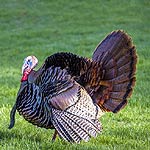 You can spot these Wild Turkeys in mixed mature woodlands, grasslands, swamp areas, and fields with crops in the New England area.
You can spot these Wild Turkeys in mixed mature woodlands, grasslands, swamp areas, and fields with crops in the New England area.
In this state, wild turkeys can be spotted in almost all places, such as the Berkshires and the forests and fields of Western Massachusetts.
![]()
3. Mourning Dove
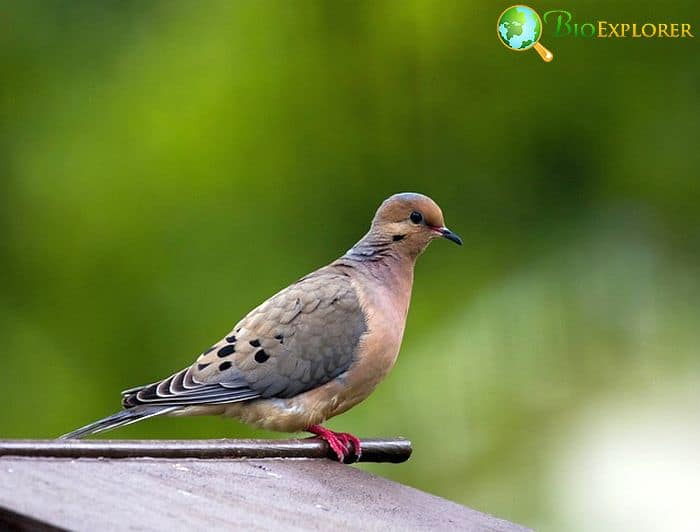
The mourning dove is a small-headed and slender-tailed bird common throughout North America.
| Animalia | Columbiformes | Columbidae | Zenaida | Zenaida macroura |
- These birds get their names from their soft calls that almost sound as if they are lamenting. Usually, their sad coo is confused with an owl’s call. Mourning doves are the most commonly hunted bird species on the continent.
- These long, plump, medium-sized doves forage seeds on the ground and are common bird feeders’ visitors. Interestingly, to aid their digestion of hard seeds, the mourning doves tend to swallow gravel.
- Both the male and female members feed their young ones with pigeon milk produced in the bird’s crop.
- Additionally, mourning doves have an in-built food stockpile known as the crop. This is an extended part of their esophagus, which expands during feeding.
- Further, mourning doves are monogamous, having only one mate for life. Sadly, these rosy-breasted-with-black-spots-on-wingbirds hunted over 70 million of them every year.
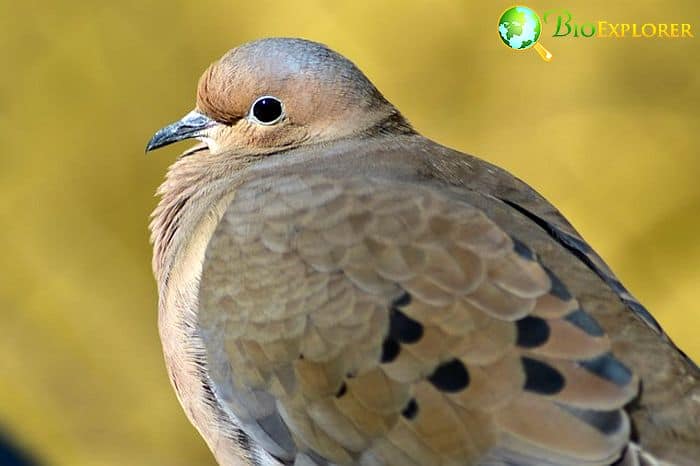
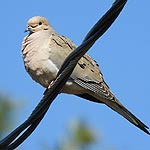 Mourning doves can be spotted pretty much everywhere in the North American continent. They prefer to live around farmlands, suburbia, woodlands, and agricultural fields. In the winter months, they travel to southern Mexico and Central America.
Mourning doves can be spotted pretty much everywhere in the North American continent. They prefer to live around farmlands, suburbia, woodlands, and agricultural fields. In the winter months, they travel to southern Mexico and Central America.
Mourning doves have built their nests in the state, particularly in cedars, pines, and conifers. This bird species is one of those that are well-adapted to man’s changes in the natural environment. For example, they can also be found in orchards, cemeteries, ornamental trees, and parks.
![]()
4. Eastern Phoebe
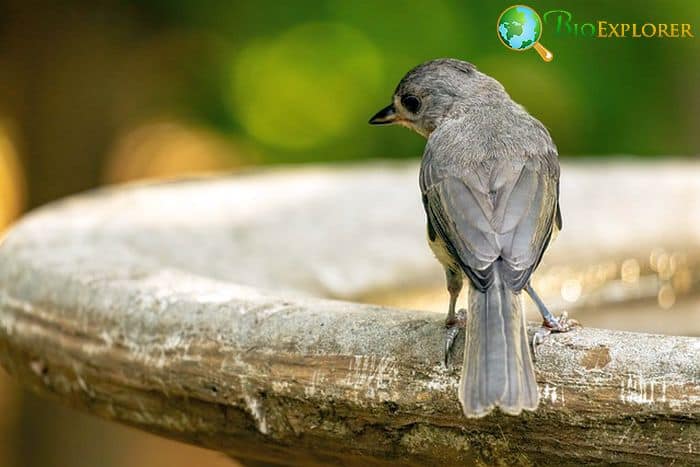
The eastern phoebe is a small plump songbird that tends to have a large head, compared to a bird its size.
| Animalia | Passeriformes | Tyrannidae | Sayornis | Sayornis phoebe |
- This bird is classified under flycatchers, the largest family in North and South America. Given the 400 species it contains.
- The name ‘Eastern Phoebe’ comes from its voice calling sounding like “fee-bee“.
- The eastern phoebe is known for flying from its perch to catch an insect in a flash. This “not-shy” bird flashes its tail upwards when perched.
- Eastern phoebes tend to live next to human occupation. They build their nests above door frames, under bridges, on buildings, culverts, rocky outcroppings, and almost exclusively on man-made structures.
- In this regard, it is worth noting that the eastern phoebes are a common sight next to homes. Apart from flying insects, they also consume small berries in the fall/winter months.

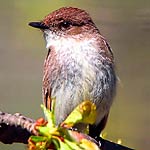 Eastern Phoebes can be spotted in any open woodland forest edges, near water, and parks across the eastern USA. In the winter, they migrate to warmer places down south to Mexico.
Eastern Phoebes can be spotted in any open woodland forest edges, near water, and parks across the eastern USA. In the winter, they migrate to warmer places down south to Mexico.
The eastern phoebes are regular nesters at the Connecticut River Valley within the Commonwealth.
![]()
5. Red-bellied Woodpecker
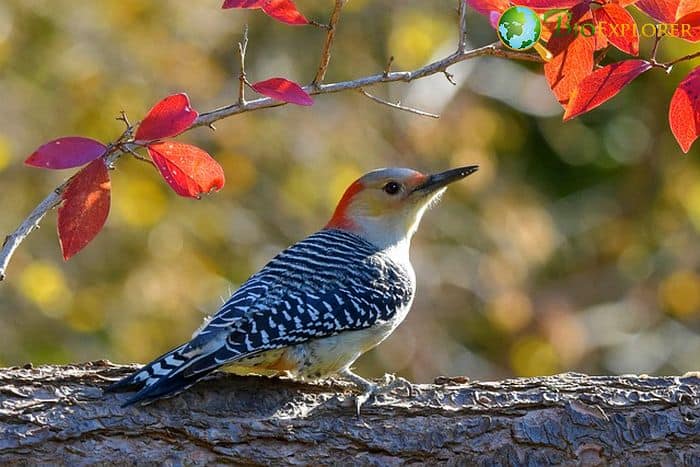
The red-bellied woodpecker has black and white coloration on their backs and redheads.
| Animalia | Piciformes | Picidae | Melanerpes | Melanerpes carolinus |
- These birds have a white chest and neck and a white belly with a red shade. These birds mainly consume insects and other organisms classified as arthropods.
- In winter, they feed on nuts, seeds, fruit, and acorns. The red-bellied woodpecker is a fierce predator known to be a key player in the biological control of invasive species.
- These attractive birds can consume 95% of the emerald ash borer caterpillar before growing into destructive adults.
- The red-bellied woodpeckers are abundant in the eastern USA, including West Virginia. Interestingly, male red-bellied woodpeckers excavate multiple holes in trees, and the female partner the best hole!
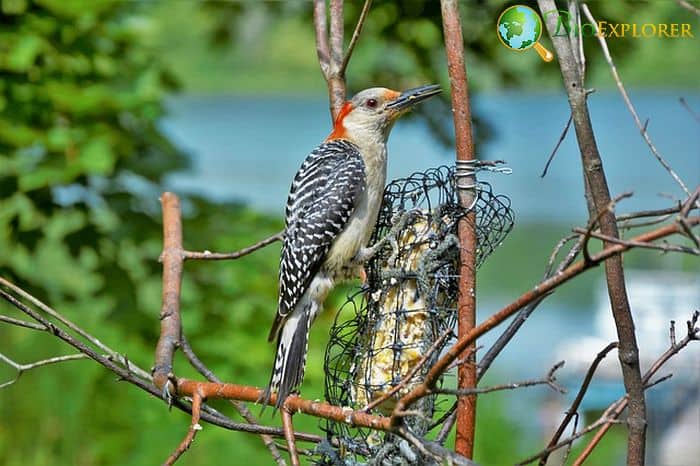
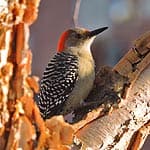 The red-bellied woodpeckers are resident in the eastern and southeastern US near swamps, suburban woodlands, and parks.
The red-bellied woodpeckers are resident in the eastern and southeastern US near swamps, suburban woodlands, and parks.
The red-bellied woodpecker was previously a rare bird in Massachusetts. It only occurred as an occasional visitor. However, in recent years, the red-bellied woodpecker increased its population in the region.
The red-bellied woodpecker has established itself in the Vineyard, particularly next to oak woodlands.
![]()
6. Baltimore Orioles
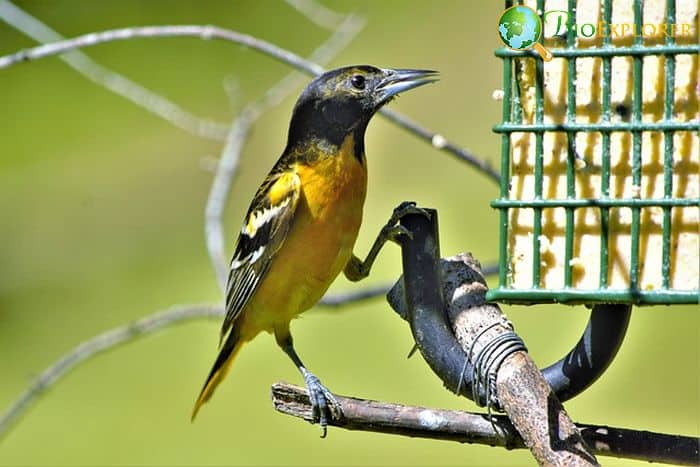
Baltimore orioles are common orioles in North America. These birds are classified as New World orioles in the genus Icterus, which also contains 30 other species.
| Animalia | Passeriformes | Icteridae | Icterus | Icterus galbula |
- Baltimore orioles display sexual dimorphism. Adult males tend to be bright orange with blackheads.
- Conversely, females are yellow to bright orange below, with olive-brown on their heads. Both males and females have white wing bars.
- Some males of this species tend to have red plumage and not orange. This irregular pigmentation has been recorded multiple times in recent years. It is believed to result from the consumption of berries produced by the honeysuckle plants introduced to the US in the mid-20th century. This phenomenon is best described as diet-induced erythrism.
- These “so-tolerant-to-humans” Baltimore orioles have basket-like hanging nests that marvel researchers to date. These nests are woven using thin grass fibers on sycamores, cottonwoods, and other tall trees.
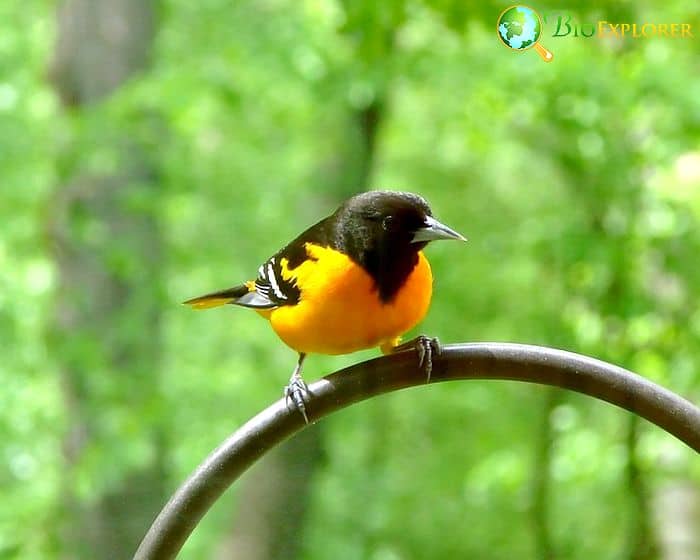
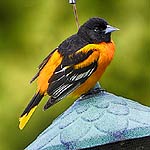 Baltimore Orioles can be mostly spotted in the eastern USA near forested parks, abundant tall trees. However, they migrate to Central and south America in the winter months.
Baltimore Orioles can be mostly spotted in the eastern USA near forested parks, abundant tall trees. However, they migrate to Central and south America in the winter months.
Baltimore orioles are likely spotted in the eastern parts of the Commonwealth. Baltimore Orioles will tend to breed in open woodlands, deciduous forests, orchards, riversides, parks, backyards, and forest edges in this region.
![]()
7. Bald Eagle
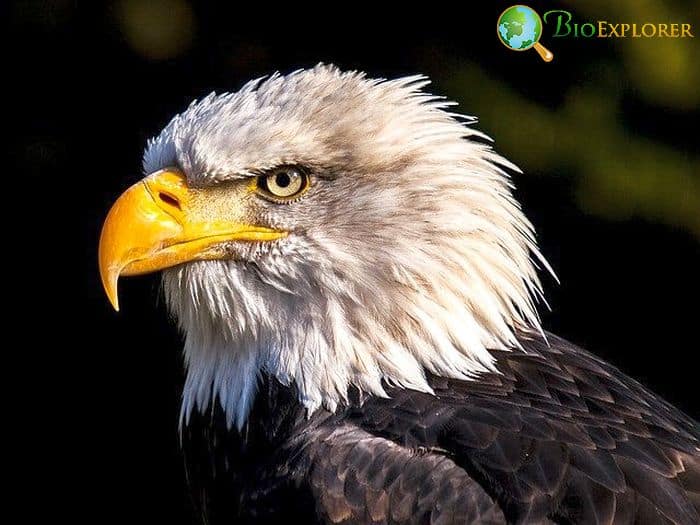
The bald eagle is one of the birds with a wide distribution in North America.
| Animalia | accipitriformes | Accipitridae | Haliaeetus | Haliaeetus leucocephalus |
- Although referred to as the bald eagle, this bird is not “really” bald. However, its white-feathered head gives the impression that it is bald.
- The bald eagles are potent predators known for their talons, which come in handy when hunting for fish. Unfortunately, bald eagles are notorious for stealing fish from Ospreys!
- Bald eagles tend to live next to water bodies to gain greater access to their preferred diet: fish. In addition, the bald eagle builds a giant nest of North American birds on tall trees.
- The nest can be large and heavy and can cause them or a tree branch to fall during storms.
- Bald eagles have excellent eyesight, which allows them to see prey as high as 3km, and successfully hunt. Before 2012, bald eagles were considered to be an endangered species in the Commonwealth.
- In the wild, bald eagles can live between 20 and 30 years old. In 1782, the bald eagle was picked as a national emblem of the USA.
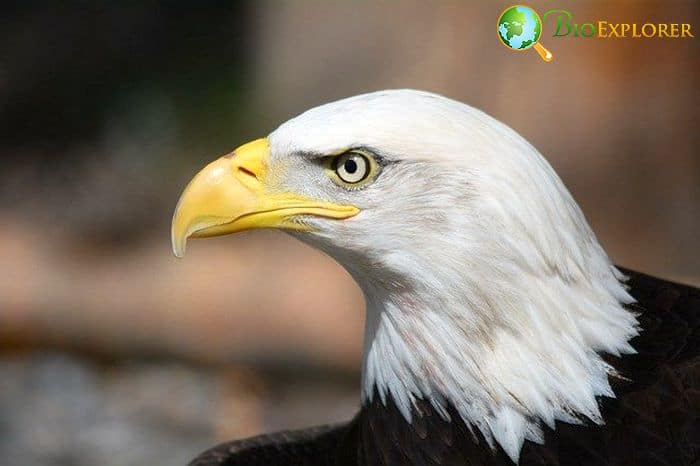
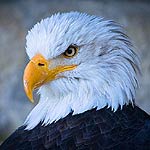 The bald eagles are widespread across Canada and the USA live around water bodies such as rivers.
The bald eagles are widespread across Canada and the USA live around water bodies such as rivers.
The bald eagle can be found roaming throughout the Commonwealth. These birds are common in Worcester County, particularly Fitchburg and Rutland. This bird has also been spotted in Wenham, Northampton, and Barnstable.
![]()
8. American Kestrel
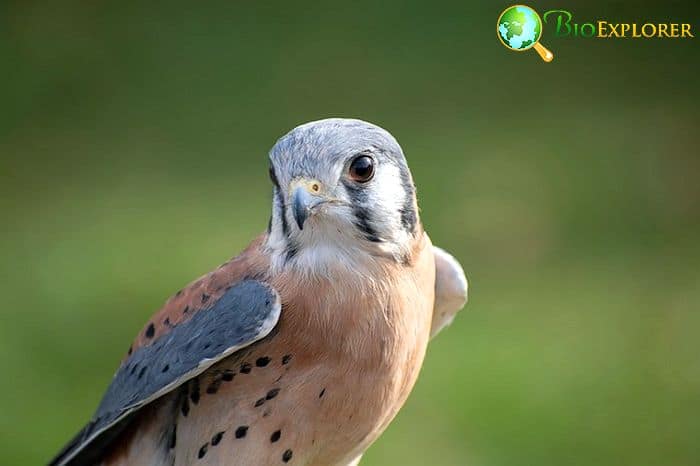
The American Kestrel is the smallest falcon, also called a sparrow hawk.
| Animalia | Falconiformes | Falconidae | Falco | Falco sparverius |
- These smallest North American birds have been observed to occur only in the New World. The males and females of this species look very different.
- Male and female species can be distinguished at three weeks old.
- Males have blue-gray wings while females have red-brown wings. Females are slightly larger compared to males.
- These kestrels do not build their nests. Instead, they nest in cavities built by other birds or nest in nesting boxes built by humans.
- These kestrels perform deep-dive into long-grass areas to catch small mammals, reptiles, and other insects (grasshoppers and crickets).
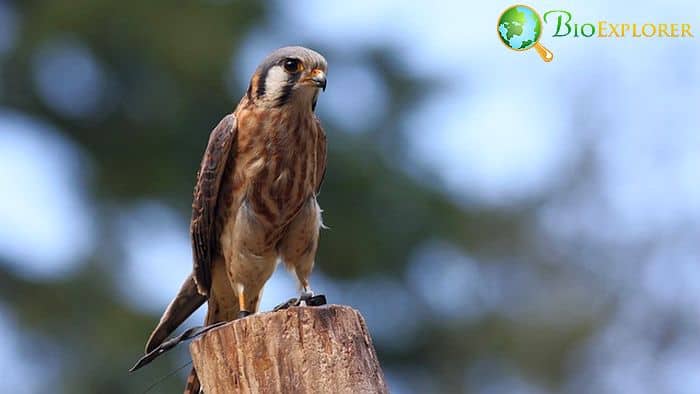
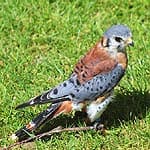 American Kestrels are found near the northern tree line in Alaska, Canada, and most of North America.
American Kestrels are found near the northern tree line in Alaska, Canada, and most of North America.
Populations of the American Kestrel can be found in many places in Massachusetts, including but not limited to Bristol/Narragansett Lowlands, Boston Basin, Cape Cod, the Islands, and the Berkshire Highlands.
![]()
9. Great Blue Heron
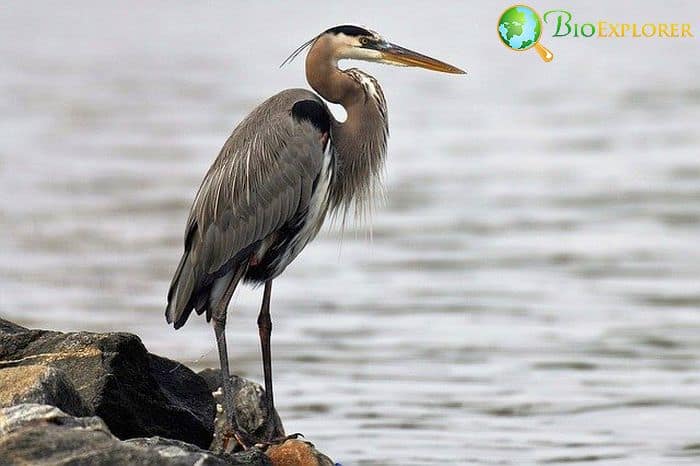
The Great Blue Heron is a large wading bird with a long neck, classified under the heron family.
| Animalia | Pelecaniformes | Ardeidae | Ardea | Ardea herodias |
- These birds can live in fresh and salty water habitats. The great blue Herons can eat virtually everything that is within their reach.
- The world’s largest herons nest primarily in trees. However, they can also nest on bushes, the ground, or artificial nest platforms. Despite being large birds, the great blue herons fly at a high speed of 30mph.
- This species’ male and female members look almost the same. The main difference is that the males are slightly larger than the females and tend to have longer ornamental plumes.
- These birds are closely related to the Gray Heron of Eurasia and the Cocoi Heron of South America. Interestingly these herons pair up only when in the nest! Other than that, they fly off individually to look for food (mainly fish) for themselves for their young.
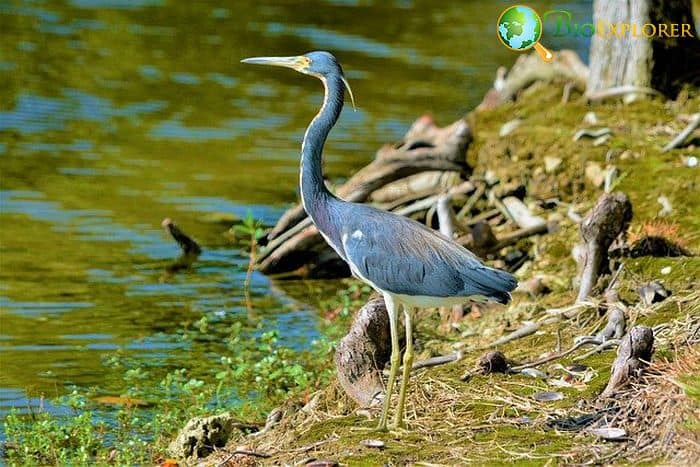
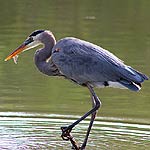 The Great Blue Heron can be spotted across waterbodies within the whole of North America, from marshes to swamps and along sea coasts.
The Great Blue Heron can be spotted across waterbodies within the whole of North America, from marshes to swamps and along sea coasts.
The great blue heron is commonly spotted within the Commonwealth, particularly next to lakes, rivers, and wetlands. This is strategic because being so close to a water body allows them reasonable access to their food. These birds are likely to be found nesting at Wollomonopoag Conservation, Wrentham.
![]()
10. Brown-headed Cowbirds
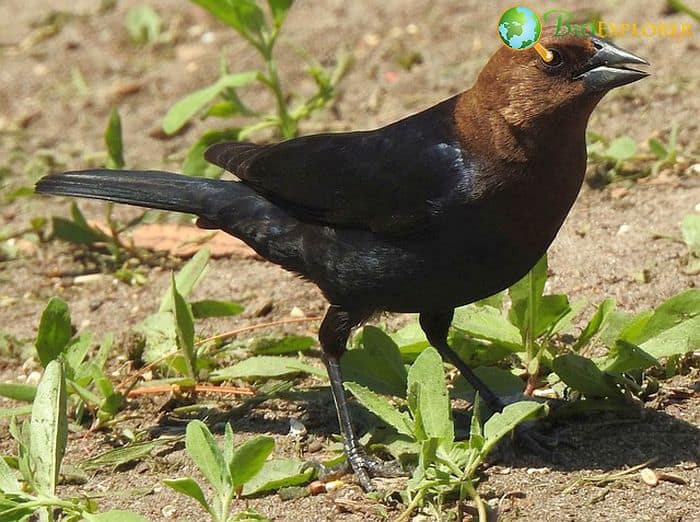
Brown-headed cowbirds are classified in the blackbird family. The brown-headed cowbirds display sexual dimorphism regarding color pattern and body size.
| Animalia | Passeriformes | Icteridae | Molothrus | Molothrus ater |
- Males have dark-brown heads and beautiful iridescent feathers, while females are gray.
- These best-known brood parasite birds never build their nests; instead, they opt to lay their eggs in other birds’ nests and leave their offspring under the care of other birds.
- It is believed that these birds were genetically programmed to do this and cannot be faulted. These birds are often social but are surprisingly solitary in the mornings.
- Brown-headed cowbirds tend to forage on the ground, particularly in open habitats. Unfortunately, due to habitat loss, these cowbirds are spread across entire North America.
- These birds feed primarily on grass seeds, cereal grains, grasshoppers, and beetles.
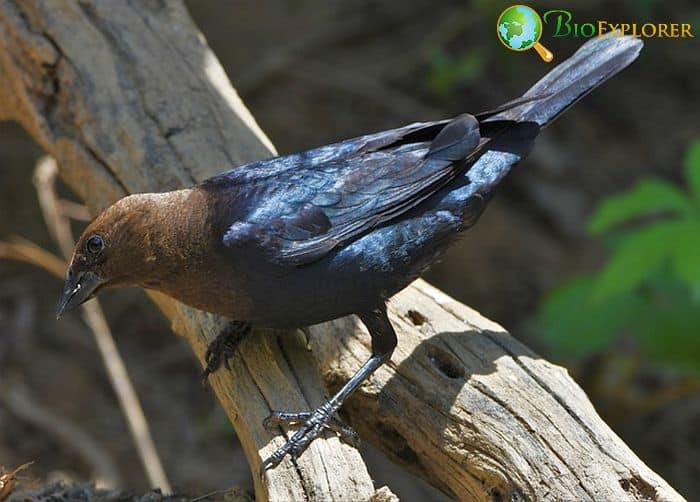
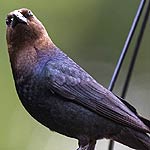 These birds are widespread across North America except in Alaska and northern Canada.
These birds are widespread across North America except in Alaska and northern Canada.
The brown-headed cowbirds can easily be spotted in Sutton, Massachusetts. Their preferred habitats include savannah, grassland, forest, agricultural land, urban areas, thickets, and riparian zones.
![]()
Despite Massachusetts’ small size (spanning 10, 554 square miles), this state houses over 300 bird species yearly. The birds found in the Commonwealth come in various sizes, types, and colors. The birds studied are just examples of the top species one is likely to encounter in the Commonwealth.
![]()


